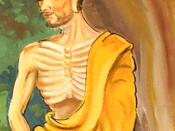Throughout life, in order for one to reach his goal, he must experience various transitions that will serve as learning experiences, to assist him in achieving his goal. Hermann Hesse demonstrates this very well in his novel, Siddhartha. Siddhartha, the main character of the story, undergoes a major transformation from the beginning of the story through the end. His transformation happens in steps, or stages, but a few had a greater influence than the rest. These few stages are the change from a Brahmin's son to a Samana, then to a businessman, and finally to a Buddha, or 'one who has found the way.' Siddhartha's first transformation occurs very early in the novel.
Siddhartha, although he is loved by many, is not happy as a Brahmin's son. He has love from others, but feels he lacks the love and happiness within himself. He yearns for more knowledge, beyond what his father is able to provide for him.
Siddhartha's decision to become a Samana plays a very major role in the path he shall lead throughout life. When he joins the Samanas, he removes all of his clothes, down to his loincloth. This was the very beginning of Siddhartha's goal to empty his inner-self, in order to refill it properly. As a Samana, Siddhartha learn many values that benefit him throughout the rest of his life. Fasting, thinking, and meditating are only a few of these basic values. In undergoing the transformation from the Brahmin's son to a Samana, Siddhartha gains a vast majority of the knowledge he will need on his quest to obtain peace within himself, yet he is only in the beginning of his transformation.
Siddhartha's next stage can be seen as a step backward, but in the end, turns out to be another...


